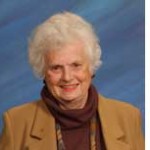This is another installment in author Natasha Josefowitz’s memoir

LA JOLLA, California — Back from our business trip/honeymoon in South America, my husband Sam’s apartment was in a basement on the west side of New York City. The small windows were right under the ceiling. We had a view of people’s feet passing by.
One day Sam invited business associates to come over for drinks. I was to serve hors d’oeuvres. Remembering my mother’s caviar canapés, but not having the money for such luxury, I bought fake caviar; it was black and looked the part. I dutifully made little sandwiches and arranged them prettily on a platter. They were sitting in the fridge waiting for the guests to arrive, but when I opened the refrigerator door to serve my lovely appetizers, all I saw was black liquid from the fake caviar running down the sides of my dish; it was a mess. I was too embarrassed to admit what had happened. Next time, I thought, I will have a can of peanuts for such emergencies. That time, however, we had drinks with nary a bite of food.
Returning home from our honeymoon, I discovered I was pregnant. Sam and I were delighted to welcome a daughter; twenty-one months later a son followed. With our expanded family we needed a larger apartment. We found one facing Central Park where I spent many happy hours sitting at the playground while my children played in the sandboxes and on the slides.
To escape the heat in New York, we rented a small summer cottage in Bound Brook, New Jersey, close to a factory where Sam was experimenting with a new fire-retardant paint (he was a chemical engineer). It turned out to be a failure, as the paint, although fire-retardant, remained sticky to the touch.
I had two children in diapers—this was before disposables—so every couple of days I would drive to the local laundromat with the kids in tow. One day Sam came home with half a dozen baby chicks, which turned out to be ducks who took over the children’s inflatable pool. The children loved running after them. We gave them to our neighbors when we returned to New York. I enjoyed those summers living out in the countryside.
Sam continued to travel on business. He would fly home for a few days and then take off again, leaving me to raise the children alone. As they got older, I wanted to pursue a career.
The Child Study Association was looking for people to read and write reviews of child development books for parents and psychologists. This was a perfect job for me as I could stay home to work and meet weekly in their offices to discuss my findings and hand in my reviews. I worked there for many years.
In 1961, the U.S. government funded a study on children in daycare. They were looking for a part-time researcher. Based on my experience, they offered me the job. As my children were in school, I accepted the position. The project involved doing a literature review of psychologists’ and psychiatrists’ writings about child development. I identified forty professionals from Europe, Israel and the U.S. willing to spend part of a summer living in a kibbutz in Israel studying different patterns of childcare and how they affect child development. This involved my spending two summers in a kibbutz in Israel, the first to prepare and the second to coordinate a symposium.
Kibbutz Dahlia was a typical, 500-member, agricultural, self-sustaining community. Children lived in a children’s house from infancy until university. They were divided into age groups with four to six children and an adult called a metapelet in each bedroom. Children spent their days at their house, eating, studying, playing, and sleeping. Parents came after work to pick them up for dinner and returned them to the children’s house to put them to bed.
The European and American participants were interested in studying farming communities to compare the children to kibbutz children. They held many discussions with the Israeli participants. The kibbutz children were seen as more secure, self-confident, and less aggressive than their counterparts with good ego development and no evidence of success strivings. Competition was between groups, but not within the group. Leadership was shared at various times. Since everything including toys were shared equally by all the children, there was no need for individual ownership, nor acquisition drive. The collective was successful in producing sociable, responsible, and contended members of the kibbutz society, with the large majority returning to the kibbutz after completing university.
It was a privilege to have organized and been involved with this group from its inception to its conclusion. Results of this study were then used in a research project for government-subsidized daycare centers in New York City.
© Natasha Josefowitz. This article appeared initially in the La Jolla Village News. You may comment to natasha.josefowitz@sdjewishworld.comN